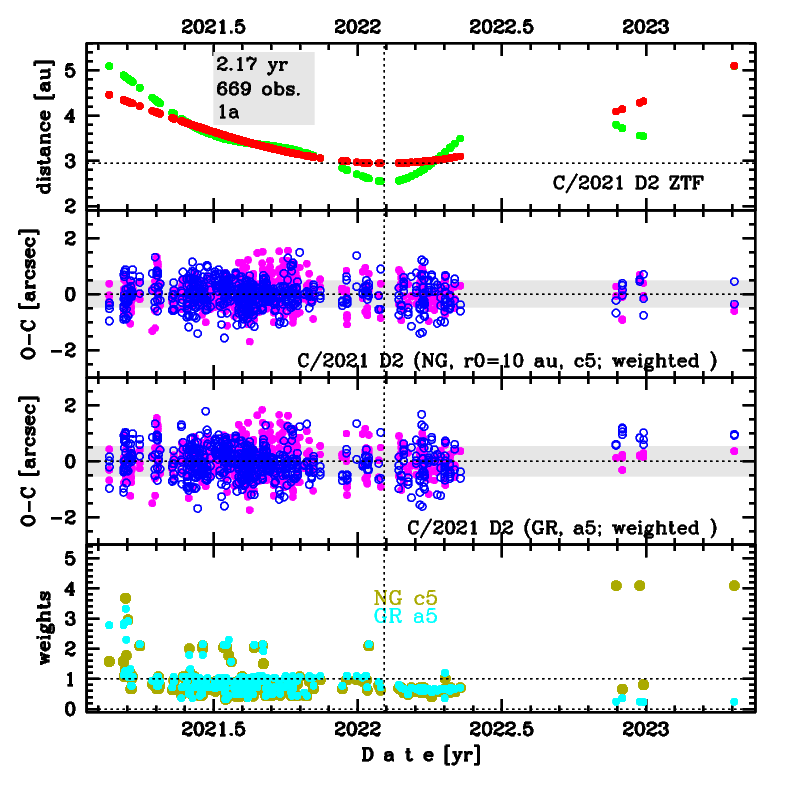C/2021 D2 ZTF
more info
Comet C/2021 D2 was discovered on 19 February 2021 by Palomar Mountain--ZTF, that is almost a year before its perihelion passage.
Comet had its closest approach to the Earth on 7 February 2022 (2.54 au), about four days after its perihelion passage.
The preferred NG solution given here is based on data span over 2.17 yr in a range of heliocentric distances: 4.46 au – 2.95 au (perihelion) – 5.10 au.
This Oort spike comet suffers small planetary perturbations during its passage through the planetary system that lead to escape the comet from the planetary zone on a hyperbolic orbit (see future barycentric orbits).
Comet had its closest approach to the Earth on 7 February 2022 (2.54 au), about four days after its perihelion passage.
The preferred NG solution given here is based on data span over 2.17 yr in a range of heliocentric distances: 4.46 au – 2.95 au (perihelion) – 5.10 au.
This Oort spike comet suffers small planetary perturbations during its passage through the planetary system that lead to escape the comet from the planetary zone on a hyperbolic orbit (see future barycentric orbits).
| solution description | ||
|---|---|---|
| number of observations | 669 | |
| data interval | 2021 02 19 – 2023 04 22 | |
| data type | perihelion within the observation arc (FULL) | |
| data arc selection | entire data set (STD) | |
| range of heliocentric distances | 4.46 au – 2.95 au (perihelion) – 5.1 au | |
| type of model of motion | NC - non-gravitational orbits for symmetric CO-g(r)-like function | |
| data weighting | YES | |
| number of residuals | 1309 | |
| RMS [arcseconds] | 0.48 | |
| orbit quality class | 1a+ | |
| previous orbit statistics, both Galactic and stellar perturbations were taken into account | ||
|---|---|---|
| no. of returning VCs in the swarm | 0 | |
| no. of escaping VCs in the swarm | 5001 | * |
| no. of hyperbolas among escaping VCs in the swarm | 0 | |
| previous reciprocal semi-major axis [10-6 au-1] | 8.15 – 9.98 – 11.71 | |
| previous perihelion distance [au] | 3040 – 3180 – 3340 | |
| previous aphelion distance [103 au] | 170 – 200 – 240 | |
| synchronous stop epoch [Myr] | -3.35 | S |
| percentage of VCs with qprev > 20 | 100 | |
| previous_g orbit statistics, here only the Galactic tide has been included | ||
|---|---|---|
| no. of returning VCs in the swarm | 0 | |
| no. of escaping VCs in the swarm | 5001 | * |
| no. of hyperbolas among escaping VCs in the swarm | 0 | |
| previous reciprocal semi-major axis [10-6 au-1] | 4.88 – 6.92 – 8.85 | |
| previous perihelion distance [au] | 40.9 – 44.5 – 48.4 | |
| previous aphelion distance [103 au] | 230 – 290 – 410 | |
| synchronous stop epoch [Myr] | -3.33 | S |
| percentage of VCs with qprev > 20 | 100 | |
